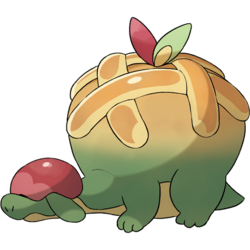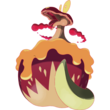From Bulbapedia, the community-driven Pokémon encyclopedia.
|
|
| Line 48: |
Line 48: |
| ==Biology== | | ==Biology== |
| {{cleanup|section|width=50%}} | | {{cleanup|section|width=50%}} |
| Appletun is a large dragon-like Pokémon inhabiting a body reminiscent of apple pie. Its body is mostly green with a yellow underside and lower jaw. It has a piece of an apple on its head worn as a helmet. Its eyes usually droop down from under the apple helmet as though they were ears, but can be lifted up to reveal leaf-like eyestalks holding small beady eyes. It has black slits for nostrils on the tip of its muzzle. It has a large hump on its back with a several overlapping stripes that resemble an apple pie's crust. It has red and green leaves on the top of its pie-like back. It has short, bulky legs with paws, and a stout tail. | | Appletun is a large dragon-like Pokémon inhabiting a body reminiscent of apple pie. Its body is mostly green with a yellow underside and lower jaw. It has a piece of an apple on its head worn as a helmet. Its eyes usually droop down from under the apple helmet as though they were ears, but may be lifted up to reveal leaf-like eyestalks holding small beady eyes. It has black slits for nostrils on the tip of its muzzle. It has a large hump on its back with a several overlapping stripes that resemble an apple pie's crust. It has red and green leaves on the top of its pie-like back. It has short, bulky legs with paws, and a stout tail. |
|
| |
|
| Appletun produces a nectar-like scent which attracts {{type|Bug}} Pokémon, which it preys on. Its body is caked in sweet nectar, which gets thicker when exposed to [[Gigantamax]] energy. The skin on is back is said to be tasty, and children used to eat it as a snack. | | Appletun produces a nectar-like scent which attracts {{type|Bug}} Pokémon, which it preys on. Its body is caked in sweet nectar, which gets thicker when exposed to [[Gigantamax]] energy. The skin on is back is said to be tasty, and children used to eat it as a snack. |
Revision as of 01:51, 2 January 2020
Appletun (Japanese: タルップル Taruppuru) is a dual-type Grass/Dragon Pokémon introduced in Generation VIII.
It evolves from Applin when exposed to a Sweet Apple. It is one of Applin's final forms, the other being Flapple. It also has a Gigantamax form.
Biology

|
This section does not yet meet the quality standards of Bulbapedia. Please feel free to edit this section to make it conform to Bulbapedia norms and conventions.
|
Appletun is a large dragon-like Pokémon inhabiting a body reminiscent of apple pie. Its body is mostly green with a yellow underside and lower jaw. It has a piece of an apple on its head worn as a helmet. Its eyes usually droop down from under the apple helmet as though they were ears, but may be lifted up to reveal leaf-like eyestalks holding small beady eyes. It has black slits for nostrils on the tip of its muzzle. It has a large hump on its back with a several overlapping stripes that resemble an apple pie's crust. It has red and green leaves on the top of its pie-like back. It has short, bulky legs with paws, and a stout tail.
Appletun produces a nectar-like scent which attracts Bug-type Pokémon, which it preys on. Its body is caked in sweet nectar, which gets thicker when exposed to Gigantamax energy. The skin on is back is said to be tasty, and children used to eat it as a snack.
When Appletun get exposed to Gigantamax energy, they change into the shape of a giant apple. The sweet nectar that covers its body increases in thickness, allowing it to absorb more damage than normal. It can shoot out nectar, enough to be able drown its opponents in the blast of nectar.
Appletun is the only known Pokémon capable of using the move Apple Acid and exclusive G-Max Move G-Max Sweetness.
In the anime
Major appearances
Minor appearances
In the manga
In the TCG
Game data
Pokédex entries
Appletun
| This Pokémon was unavailable prior to Generation VIII.
|
| Generation VIII
|
|
|
Galar
#207
|
| Sword
|
Eating a sweet apple caused its evolution. A nectarous scent wafts from its body, luring in the bug Pokémon it preys on.
|
| Shield
|
Its body is covered in sweet nectar, and the skin on its back is especially yummy. Children used to have it as a snack.
|
|
|
Gigantamax Appletun
| This Pokémon was unavailable prior to Generation VIII.
|
| Generation VIII
|
|
|
Galar
#207
|
| Sword
|
It blasts its opponents with massive amounts of sweet, sticky nectar, drowning them under the deluge.
|
| Shield
|
Due to Gigantamax energy, this Pokémon's nectar has thickened. The increased viscosity lets the nectar absorb more damage than before.
|
|
|
Game locations
| This Pokémon was unavailable prior to Generation VIII.
|
|
|
Stats
Base stats
| Stat
|
Range
|
| At Lv. 50
|
At Lv. 100
|
110
|
|
170 - 217
|
330 - 424
|
85
|
|
81 - 150
|
157 - 295
|
80
|
|
76 - 145
|
148 - 284
|
100
|
|
94 - 167
|
184 - 328
|
80
|
|
76 - 145
|
148 - 284
|
30
|
|
31 - 90
|
58 - 174
|
Total: 485
|
Other Pokémon with this total
|
- Minimum stats are calculated with 0 EVs, IVs of 0, and (if applicable) a hindering nature.
- Maximum stats are calculated with 252 EVs, IVs of 31, and (if applicable) a helpful nature.
|
Type effectiveness
| Under normal battle conditions in Generation IX, this Pokémon is:
|
|
|
|
|
|
|
|
|
|
|
|
|
Learnset
|
|
|
|
- Bold indicates a move that gets STAB when used by Appletun
- Italic indicates a move that gets STAB only when used by an Evolution of Appletun
|
|
|
|
|
- Bold indicates a move that gets STAB when used by Appletun
- Italic indicates a move that gets STAB only when used by an Evolution of Appletun
|
|
|
|
|
- Moves marked with an asterisk (*) must be chain bred onto Appletun in Generation VIII
- Moves marked with a double dagger (‡) can only be bred from a Pokémon who learned the move in an earlier generation.
- Moves marked with a superscript game abbreviation can only be bred onto Appletun in that game.
- Bold indicates a move that gets STAB when used by Appletun
- Italic indicates a move that gets STAB only when used by an Evolution of Appletun
|
|
|
|
|
- Bold indicates a move that gets STAB when used by Appletun
- Italic indicates a move that gets STAB only when used by an Evolution of Appletun
|
|
|
|
|
- Bold indicates a move that gets STAB when used by Appletun
- Italic indicates a move that gets STAB only when used by an Evolution of Appletun
|
Evolution
Forms
Gigantamax
Trivia
- Appletun and Flapple have physically identical Gigantamax forms, but they are still treated as different Pokémon as they have distinct Pokédex entries and G-Max Moves.
- Appletun and its evolutionary family are the only Pokémon that are in the Grass and Dragon Egg Groups.
Origin
Appletun may be based on Ladon, a dragon from Greek mythology that guards the golden apples in the Garden of the Hesperides. It may also draw inspiration from the biblical serpents, sometimes referred to as dragons, one of which persuades Eve to eat from the forbidden fruit of the Tree of the knowledge of good and evil, most of the times depicted as an apple. Appletun may also be based on the tale of Bel and the Dragon, about a dragon that bursts open after being fed a cake. It may also be inspired by apple pies and tortoises. Its Gigantamax form appears to be based on a caramel apple.
Name origin
Appletun may be derived from Appleton, a toponym that means "an orchard" or "place where apples grow". Appletun may also be a combination of apple and ton (referencing its bulk). It may also be a play on apple turnover.
Taruppuru may be a combination of tart, 怠い tarui (sluggish), たっぷり tappuri (onomatopoetic word for plenty), and apple.
In other languages
| Language
|
Title
|
Meaning
|
 Japanese Japanese
|
タルップル Taruppuru
|
From tart, 怠い tarui, たっぷり tappuri, and apple
|
 French French
|
Dratatin
|
From dragon and tarte tatin
|
 Spanish Spanish
|
Appletun
|
Same as English name
|
 German German
|
Schlapfel
|
From schlapp and Apfel
|
 Italian Italian
|
Appletun
|
Same as English name
|
 Korean Korean
|
단지래플 Danjiraepeul
|
From 단 dan, 지루하다 jiruhada, and apple
|
 Mandarin Chinese Mandarin Chinese
|
豐蜜龍 / 丰蜜龙 Fēngmìlóng
|
From 豐 fēng, 蜜 mì, 蜂蜜 fēngmì, and 龍 lóng
|
 Cantonese Chinese Cantonese Chinese
|
豐蜜龍 Fūngmahtlùhng
|
From 豐 fūng, 蜜 maht, 蜂蜜 fūngmaht, and 龍 lùhng
|
|
|
|
|
|
|
|
Related articles
External links

|
This Pokémon article is part of Project Pokédex, a Bulbapedia project that aims to write comprehensive articles on each Pokémon species, as well as Pokémon groups and forms.
|






